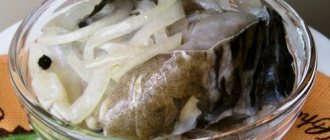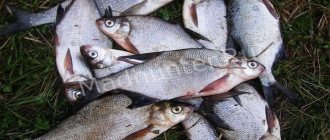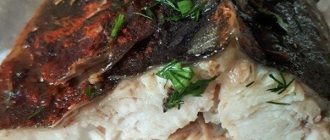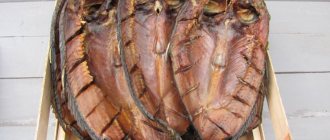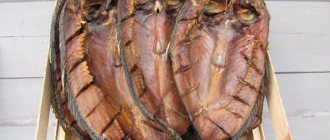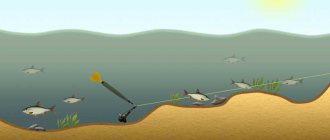Fishing and angling for different types of fish differ in the methods and baits used, baits and baits, and the necessary gear.
Famous for its caution and timidity, bream is quite a serious trophy for anyone who appreciates good fishing and is willing to spend a little time on preliminary preparation.

The photos of bream presented in this article and practical recommendations from fishing experts will help you explore new horizons in fishing.

Such representatives of the aquatic world are caught all year round, but for each season and different fishing conditions it is necessary to select special baits and baits, tackle and a fishing rod, which guarantees a good result.
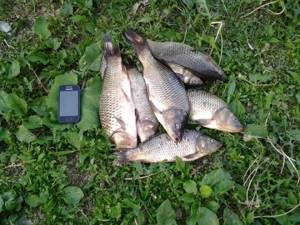
Origin of the species and description
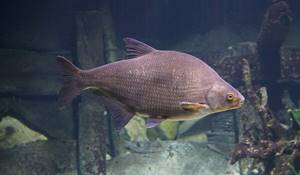
Photo: Bream
Bream is a monotopic species, the only representative of a unique genus of bream from the large cyprinid family. Bream is a ray-finned fish, the ancient fossils of which belong to the third period of the Paleozoic, which is about four 400 million years ago.
Video: Bream
Despite the uniqueness of the genus, ichthyologists attribute 16 species of fish to it, but only three species groups have survived to this day:
- common bream;
- Danube;
- Oriental.
They all differ from each other only in their sizes. Despite the fact that bream is the desired prey of all fishermen, many of them mistakenly mistake young bream for a separate species of fish and even give it a name - bream. This happens due to the fact that young animals have a slightly different appearance than adults. In ichthyology, there is no such term as white bream. Quite often, inexperienced fishermen confuse young bream with silver bream, which also belongs to the carp family and has only minor external differences from the white bream.
Interesting fact: Some people believe that bream is very bony and has dry meat, but this only applies to young animals, and the meat of adults is considered almost as fatty as beluga and can contain up to 9 percent healthy fat.
Brief description of bream fish and its features
Every fisherman will say that fishing for bream is a real pleasure, because it is a very careful and quite strong fish.
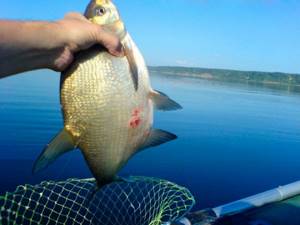
Large representatives of their species have a rather specific appearance, which prevents them from being confused with other aquatic inhabitants; they are distinguished by a laterally flattened body of a round and oval shape.
Read here Ruff - the secrets of the ruff fishing technique, the necessary gear, bait and bait options (110 photos)
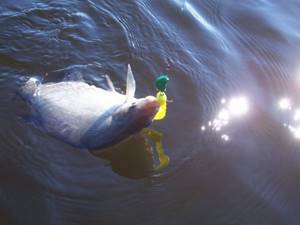
Young bream are often confused with silver bream, which is facilitated by their external similarity; old bream are characterized by their enormous size and extreme caution in behavior.
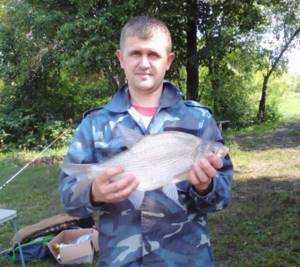
Appearance and features
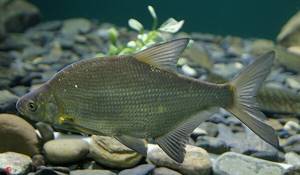
Photo: What bream looks like
All three species groups of bream have a rather rounded body, strongly compressed on the sides, the main feature of which is that its height is equal to a third of its length. The scales are moderate in size in the middle of the body and smaller in the area of the head and tail. There are no scales between the ventral and anal fins, as well as on the midline of the anterior part of the back. The dorsal fin is high, but short without a spine, located above the space between the anal and ventral fins. The anal fin consists of a large number of rays, which are never less than twelve.
Adult common bream have a gray or brown back, golden brown sides, and a yellow belly. The fins are all gray with a dark border. The bream has a small head; its mouth is a small tube that can extend. In adult individuals, pharyngeal teeth are formed in one row of 5 pieces on each side of the mouth. A ten-year-old bream has an average length of 70–80 cm, while reaching a weight of 5–6 kg.
Juveniles differ significantly from mature ones:
- they have a smaller body size;
- lighter silver color;
- their body is more elongated.
Some species of bream can have a completely black color, for example the black Amur bream, which has a limited habitat - the Amur River basin. This is a very rare species and its life is poorly studied.
Interesting fact: It is very easy to distinguish the white bream from the white bream by the color of its fins - young bream have gray fins, while the white bream have red ones.
Types of bream
European inhabitants
Depending on the age, size and color of the scales, they are called differently among anglers. For example, small species of bream that have just left the fry stage are called weasel. Often, if they are hooked, fishermen release them to grow to full consumer size.
Young individuals within 1 kg are often referred to as bream and bream. They are distinguished by light, silvery-white scales and an oblong, narrow body. And bream itself is called adult specimens that reach a weight of 2 – 2-5 kg. The largest representatives of this species are called chebak. They live in holes and in the deepest places of the bottom, have a dark color and a characteristic hump.
Far Eastern species
The freshwater fauna of the Amur River in the Far East includes two distinct species: white bream and black bream.
White bream looks approximately the same as the one familiar to our fishermen: a four-kilogram individual rarely exceeds 50 cm in length. Its back is slightly darker, with a greenish, even brown tint, and its belly is silvery. The bream fish feeds mainly on diatoms, but does not refuse (during periods of high water) terrestrial vegetation. Black Amur bream lives next to white bream, but in much smaller numbers. The color corresponds to the name - its back is almost black, only silvery glimpses are noticeable on the sides.
Where does bream live?
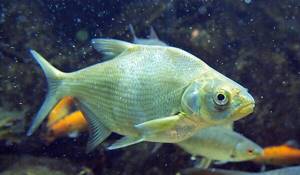
Photo: Bream in Russia
This type of fish lives in large numbers in rivers, lakes, and reservoirs with a sandy or muddy bottom. Their natural habitat covers the basins of the Black, Caspian, Azov, Baltic, Aral, Barents and White seas.
At the mouths of large, full-flowing rivers that flow into these seas, a semi-anadromous form of bream lives, entering the river waters to spawn. It is not found in high mountain rivers and lakes of the Caucasus, as well as in the southern CIS countries. Bream is a common fish for Northern and Central Europe, Northern Asia, and North America.
Bream prefers to be in reservoirs where there is a weak current or no current at all. It is more often found in creeks and deep holes. Adult individuals rarely come close to the shores, staying at a considerable distance from the coastline. Young ones prefer coastal waters, where they hide in coastal thickets. Bream overwinter in deep holes, and some species emerge from rivers into the sea.
Interesting fact: Bream fishing is possible throughout the year, with the exception of the spawning season. It is caught in open water during the warm season and from ice in the winter months. Zhor begins in early June and lasts until mid-summer, and then resumes again by September. During periods of famine, bream bites at any time of the day.
Now you know where the bream fish is found. Let's see what he eats.
What does bream eat?
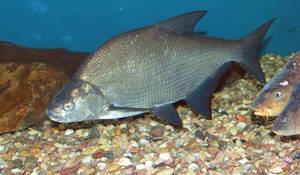
Photo: Bream fish
Bream can feed directly from the bottom of the reservoir due to the special structure of its mouth. Adults literally explode the muddy or sandy bottom in search of food, and in a short period of time huge schools of bream are capable of completely clearing large areas of the bottom space. The movement of bream during feeding produces a large number of air bubbles rising to the surface from the bottom.
Since this fish has weak pharyngeal teeth, its usual diet consists of shells, algae, small bottom invertebrates, bloodworms, snails and larvae of other fish species. During feeding, the bream absorbs water along with food, which is then retained with the help of special outgrowths. The unique feeding mechanism allowed this representative of the carp family to become the dominant species in its natural habitat and significantly displace the silver bream, roach and a number of other species of river fish.
In winter, especially in its second half, bream is inactive, feeds rarely and sparingly. This is primarily due to a lack of oxygen and low water temperatures, as well as the accumulation of various gases under the ice, which then partially dissolve in the water.
Interesting fact: Adult bream that have lived 10-15 years can gain weight of more than 8 kg with a body length of about 75 centimeters. In warm waters, growth rates are much higher than in cold waters. It has been noticed that individuals living in rivers do not gain much weight.
Features of character and lifestyle
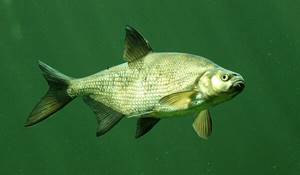
Photo: Bream in the water
Bream is a social fish that gathers in huge groups. At the head of the herd there are always large adults who coordinate movements. In the warm season, schools of fish are located in places with weak currents or standing water and feed almost constantly. Since bream is a very timid and cautious creature, during daylight hours it is at depth, but at night a large number of individuals go ashore to search for food, and this is the time that is considered the best for fishing
They spend deep autumn and winter in “wintering” pits and as soon as the ice begins to melt, the bream goes to its feeding areas. Breams always occupy their wintering places in an organized manner. All large specimens settle in the deepest places, smaller specimens are located higher, and at the same time the fish seem to be calibrated in size.
Ichthyologists believe that the special organization of wintering was not chosen by chance. With this placement order, metabolic processes in the fish’s body are less intense than during wintering alone, which means that strength and energy are saved.
It has been noted that sedentary forms of bream, which never migrate to other bodies of water for spawning or feeding, can live up to 30 years. The semi-through form has a life cycle that is half as long.
Lifestyle of bream
According to most anglers, bream is an inhabitant only of freshwater bodies. But this is not so - they fish for it in the waters of the Caspian, Azov and Aral seas. Biologists believe that there is freshwater bream, as well as sea bream.
The way of life of bream is that it forms large schools (shoals) and stays in deep places with a large percentage of vegetation. At the bottom, bream are attracted to a good diet: benthos - microorganisms of animal and plant origin that are concentrated in the silt layer, or at the very bottom. Fish are also attracted to algae and other aquatic plants that grow in shallows and off the coast.
The feeding system of bream also has interesting features. In those reservoirs where a large population of this fish lives, an interesting phenomenon can often be observed. Bream form a school and move along the bottom like a harvester, collecting all the organic food. Such a school can be seen from the shore: its route is visible from the bubbles that the fish releases while moving in the silt layer.
Social structure and reproduction
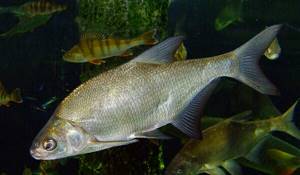
Photo: Bream in the water
Depending on climate conditions, bream become sexually mature at different times. In warm areas at the age of 3-5 years, in cold waters puberty occurs at 6-9 years. The climate also affects the start time of spawning: in the central part of the country, bream spawning begins in early May, sometimes in June, in the south in April, in the north only in July.
With the onset of an important period, the males change their color to a darker one, and specific tubercles appear on their heads, resembling small warts. A school of bream is divided into separate groups according to age. The whole flock does not leave for spawning at once, but in groups one after another. Each of them spawns from 3 to 5 days, depending on weather vagaries. Shallow water areas with plenty of vegetation are selected for spawning grounds. It is easy to recognize spawning bream - their flat, massive backs periodically appear on the surface of the water. Regardless of the bream’s habitat and weather, spawning lasts at least a month.
One adult is capable of laying up to 150 thousand eggs at a time. The female attaches strips with yellow eggs to algae, and those that cannot be attached float to the surface and are eaten by fish. After 6-8 days the larvae appear, and after a month the fry appear. If the temperature drops below 10 degrees, then mass death of eggs may occur.
At first, the fry swim together with the young of other fish species, and at the end of summer or autumn they gather in large schools. They are constantly in search of food and within a couple of months they grow up to ten centimeters in length. They will remain in the spawning areas until spring, and the adults, after completing the important process, go to the depths and, having recovered from illness, begin to feed again.
Bream spawning
After wintering, the pre-spawning run of bream begins. In the lower reaches of the Volga - at the end of February, in the south this process starts in mid-April, and in the middle zone and in the north - no earlier than the beginning of May. Bream spawning takes place in 3 periods, with a total duration of about 1 month. The first period begins at a water temperature of about 14 degrees - then bream and small bream come out to spawn. Medium, 1.5-2 kilogram individuals begin it during the flowering period of bird cherry, and large fish - during the formation of cereal ears. The favorite time for spawning of these cyprinids is early morning, because they are shy and love silence.
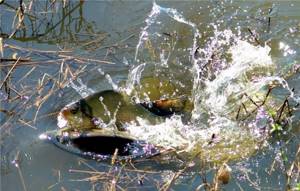
Preparation for spawning in bream begins at 5 years of age. Males change 1-2 weeks before spawning - the color of the scales darkens, growths can be seen on the head, and a rash similar to warts appears on the body.
Bream fish spawn in those sections of a river or lake where vegetation is well developed - most often these are spring shallows along the banks, as well as shallow areas where fish permanently reside. The process itself can be seen on the surface of the water - the mating games of bream are noisy.
Bream eggs attach to plants (females are very prolific - they lay up to 150 thousand eggs), and within a week the larvae appear. If the water in the reservoir is warm, this period can be reduced to 4-5 days. After just over two months, they grow from fry to 12 centimeter individuals.
Natural enemies of bream
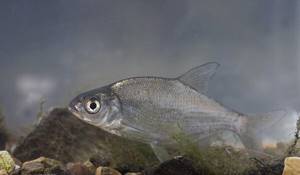
Photo: Bream fish
Bream fry have a better chance of survival at the beginning of their life cycle compared to young fish of other fish species, as they are characterized by high rates of growth and development. It is in the first year or two after birth that young individuals are most vulnerable and can be eaten by many predators, such as pike. By the age of three, they are practically not in danger, but catfish or large specimens of bottom pike can successfully attack adult bream.
In addition to some predatory fish, this unique genus is threatened by several types of parasites that live in abundance on the bodies of breams. They enter the water along with the feces of various birds that feed on fish, and then, together with the food, end up inside the bream. Developing in the intestines of fish, parasites can cause the death of even strong adult fish.
Fish especially suffer from them in the summer months, when the water in reservoirs is well warmed by the sun's rays. Saltpeter and a fungal disease of the gills - bronchimniosis - are very dangerous. Sick, weakened individuals stop eating normally and often become prey for reservoir attendants - seagulls and large pikes. Despite the harm caused by parasites, they do not have much influence on the population of this representative of the cyprinid family.
Population and species status
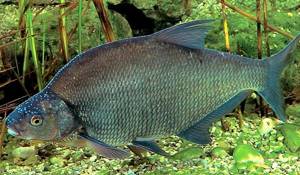
Photo: Common bream
The total number of bream can fluctuate significantly depending on the degree of spawning success. The main condition for spawning is high floods. Recently, there has been a decrease in the number of natural spawning grounds, which cannot but affect the rate of population growth of this species.
But thanks to the very high fertility and rapid rate of development of the young, the small number of enemies in the natural habitat, the general population of the unique representative of the genus of bream is currently not in danger and its status is stable. Only the black Amur bream, which is listed in the Red Book of Russia, is in danger.
The bream fishery is currently small. It is carried out only in spring and autumn. Existing fishing rules provide for more rational use of the main bream population. To preserve stocks of commercial fish, special nursery fisheries have been created, and measures are being taken to rescue young bream from small reservoirs after losing contact with large rivers. For more efficient spawning, floating spawning grounds are used.
Interesting fact: Bream is a peaceful fish and only sometimes can exhibit predatory habits, reacting to spinners and baits, so fishing with a spinning rod does not always bring results.

